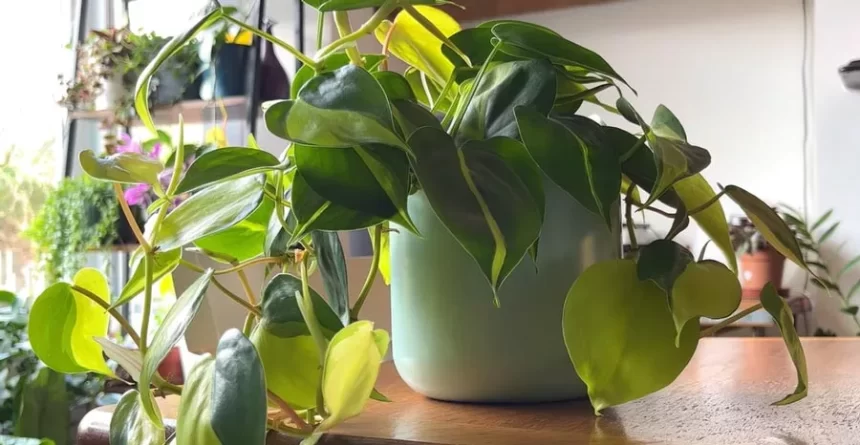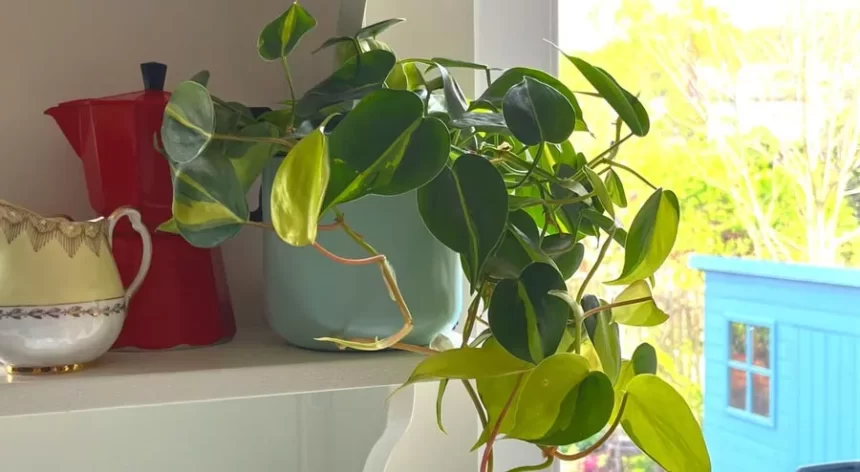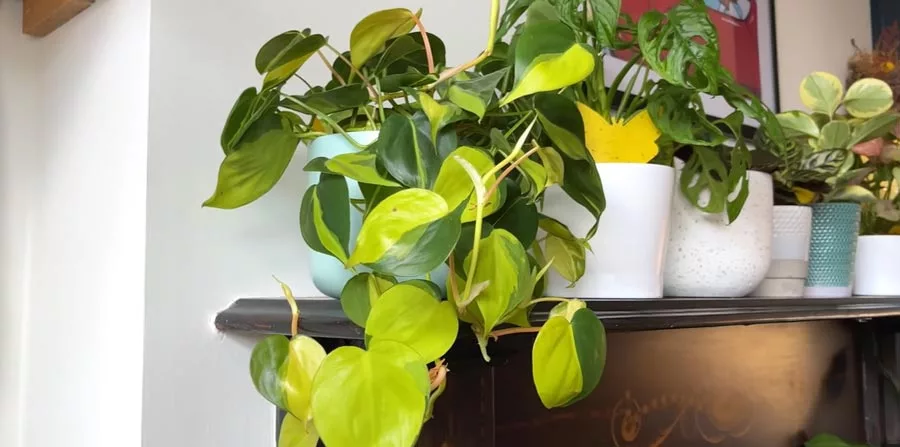Philodendron houseplants are one of the most popular plants for indoor use. There are many different varieties, each with its own unique care needs. In this blog post, we will explore some of the rarer philodendron varieties and provide tips on how to propagate them.
We’ll also share some secret tips for keeping your philodendrons healthy and looking their best!
Philodendron Houseplants
Philodendron is a type of plant that is popular to have in your house. They are easy to take care of and you can also propagate them, which means you can make more Philodendron plants from the ones you have. Philodendrons come from tropical and subtropical areas of the world. There are around 20 different Philodendron species.

Philodendron Care
Philodendrons are easy to care for and propagate, and most varieties thrive in tropical and subtropical climates. However, there are a few things you should keep in mind when caring for Philodendrons.
Light
Philodendrons need medium to high levels of light. They can tolerate low light, but they will not grow as quickly or bloom as often in low light conditions. Philodendrons prefer bright, indirect light. If the plant is in direct sunlight, the leaves will turn yellow and scorch.
Tips for providing Philodendrons with the right amount of light:
-Place Philodendrons near a bright window, out of direct sunlight.
-Rotate Philodendrons regularly so that all sides of the plant get evenly lit.
-If Philodendrons are not getting enough light, they will grow leggy and their leaves will be smaller.
Soil
Philodendrons prefer well-draining, humus-rich soil. They do not like to sit in wet soil, as this can lead to root rot. Philodendrons will tolerate a wide range of soils, as long as they are well-draining.
Tips for providing Philodendrons with well-draining soil:
-Add perlite or vermiculite to regular potting soil to improve drainage.
-Create a makeshift well in the center of the pot that will allow water to drain away from the roots.
-If Philodendrons are sitting in wet soil, they will start to yellow and their leaves will drop off.
Water
Philodendrons like to be kept moist, but not soggy. They should be watered when the top inch of soil is dry. Philodendrons are very susceptible to root rot, so it is important to make sure that they are not sitting in wet soil.
Tips for watering Philodendrons:
-Water Philodendrons when the top inch of soil is dry.
-Feel the soil before watering to make sure that it is actually dry and not just cool to the touch.
-Use lukewarm water when watering Philodendrons, as cold water can shock the plant.
-If Philodendrons are sitting in wet soil, they will start to yellow and their leaves will drop off.

Humidity

Philodendrons prefer high humidity levels, but they will tolerate lower humidity levels. If the air is too dry, Philodendrons will start to drop their leaves.
Tips for providing Philodendrons with enough humidity:
– mist Philodendrons regularly with lukewarm water.
– Place Philodendrons on a pebble tray filled with water.
– Group Philodendrons together with other plants to create a mini humidifier.
– If Philodendrons are not getting enough humidity, their leaves will start to turn brown and drop off.
Temperature
Philodendrons prefer warm temperatures, between 60 and 85 degrees Fahrenheit. They will tolerate cooler temperatures, but they may go into dormancy if the temperature drops below 60 degrees Fahrenheit. Philodendrons will also suffer if the temperature gets too hot, above 85 degrees Fahrenheit.
Tips for providing Philodendrons with the right temperature:
– Philodendrons should be kept in a warm room, between 60 and 85 degrees Fahrenheit.
– Philodendrons can tolerate cooler temperatures, but they may go into dormancy if the temperature drops below 60 degrees Fahrenheit.
– Philodendrons will also suffer if the temperature gets too hot, above 85 degrees Fahrenheit.
Fertilizer
Philodendrons should be fertilized monthly during the growing season, from spring to fall. They can be fertilized less often during the winter months. It is important to use a balanced fertilizer so that the Philodendron does not get too much or too little of any one nutrient.
Tips for fertilizing Philodendrons:
– Philodendrons should be fertilized monthly during the growing season, from spring to fall.
– Philodendrons can be fertilized less often during the winter months.
– It is important to use a balanced fertilizer so that the Philodendron does not get too much or too little of any one nutrient.
– If Philodendrons are over-fertilized, their leaves will start to burn.
Pruning
Philodendrons can be pruned to remove damaged or yellow leaves, encourage bushy growth, or shape the plant. Philodendrons can be pruned at any time of year.
Tips for pruning Philodendrons:
– Philodendrons can be pruned to remove damaged or yellow leaves, to encourage bushy growth, or to shape the plant.
– Philodendrons can be pruned at any time of year.
– When pruning Philodendrons, be sure to use clean, sharp shears.
– Philodendrons will bleed sap when they are cut, so it is best to do your pruning in the morning so that the sap has time to dry during the day.

Propagation
Philodendrons can be propagated by seed, stem cuttings, or air layering. Philodendron seeds need to be fresh in order to germinate, so they should be collected from the plant as soon as they ripen. Philodendron stem cuttings can be taken at any time of year, but they will root more quickly if they are taken during the growing season. Philodendrons can also be propagated by air layering, which is a good method to use for Philodendrons that are difficult to propagate by other methods.
Tips for propagating Philodendrons:
- Philodendrons can be propagated by seed, stem cuttings, or air layering.
- Philodendron seeds need to be fresh in order to germinate, so they should be collected from the plant as soon as they ripen.
- Philodendron stem cuttings can be taken at any time of year, but they will root more quickly if they are taken during the growing season.
- Philodendrons can also be propagated by air layering, which is a good method to use for Philodendrons that are difficult to propagate by other methods.
- Philodendron cuttings will root more quickly if they are placed in a humid environment.
Types
There are around 20 species of Philodendron, and they can be found in tropical and subtropical regions of the world. Philodendrons come in a variety of shapes and sizes, and there are many different varieties to choose from. Some of the most popular Philodendron varieties include:
Philodendron hederaceum
Philodendron hederaceum is a climbing Philodendron that can reach up to 20 feet in length. The leaves of this Philodendron are dark green and glossy, and they have a heart-shaped appearance.
Philodendron scandens
Philodendron scandens is a vining Philodendron that is also known as the sweetheart plant. The leaves of this Philodendron are heart-shaped and have a deep green color.

Philodendron erubescens
Philodendron erubescens is a climbing Philodendron that is also known as the blushing Philodendron. The leaves of this Philodendron are dark green with red or pink accents.
Philodendron bipinnatifidum
Philodendron bipinnatifidum is a large Philodendron that can reach up to 10 feet in length. The leaves of this Philodendron are deeply divided and have a fern-like appearance.
Overwintering
Philodendrons are tropical plants that need to be overwintered in a warm, humid environment. The best way to overwinter Philodendrons is to place them in a greenhouse or sunroom. If you don’t have a greenhouse or sunroom, you can place them in a sunny spot near a window.
Make sure the Philodendrons are in a spot where they will receive at least six hours of sunlight per day. Philodendrons need to be watered regularly, and the soil should be kept moist but not soggy.
In the winter, Philodendrons will go dormant and will not need as much water. Fertilize Philodendrons every two weeks during the growing season, and once a month during the winter.

Philodendrons can be propagated by division or from stem cuttings. To divide Philodendrons, carefully remove the plant from its pot and then divide the root ball into two or three sections.
Replant each section in its own pot. Philodendron stem cuttings can be taken from new growth in the spring or summer.
Cut a 4-6 inch piece of stem and remove the bottom leaves. Place the cutting in a pot of moist soil, and keep it in a warm, humid environment until it roots.
Philodendrons are beautiful plants that are easy to care for. With a little bit of effort, you can have a Philodendron that will thrive for many years.
Problems
One of the most common problems with Philodendron plants is leaf spot. This is a fungus that causes brown spots on the leaves. If left untreated, the spots can grow and spread, eventually killing the plant. To prevent leaf spots, make sure to water your Philodendron correctly and avoid over-fertilizing it. If you see any spots on the leaves, remove them immediately and treat the plant with a fungicide.
Another common issue is root rot. This is caused by too much water, and it can quickly kill Philodendron plants. To prevent root rot, make sure the pot has drainage holes and that you are not watering the plant too often. If you see that the roots are starting to rot, remove the plant from the pot and replant it in fresh soil.
Philodendron plants are also susceptible to mealybugs. These pests suck the sap from the leaves and can cause them to turn yellow and wilt. To get rid of mealybugs, wipe them off the leaves with a damp cloth. You can also treat the plant with an insecticide.

Philodendron benefits

Philodendrons are a great addition to any home because they offer a number of benefits. Philodendrons improve air quality by removing toxins from the air, boost your mood and energy levels, and they can help you get a better night’s sleep. Philodendrons are also easy to care for and propagate, making them a great choice for those who are new to plant care.
Repot them every two years in springtime
Philodendron plants need to be repotted every two years in the springtime. You will know it is time to repot your Philodendron when you see roots coming out of the drainage holes in the bottom of the pot. When repotting, be sure to use a well-draining potting mix and a pot that is only one size larger than the current pot.
How to buy a Philodendron plant at the best price
You can buy Philodendron plants at many places, like a store or the internet. Sometimes you can find Philodendrons on sale. When you are looking to buy a Philodendron plant, it is important to find the best price. You can do this by comparing prices at different stores or online. You can also look for Philodendron plants that are on sale.
secret tips
There are a few secret tips for keeping Philodendron plants healthy and happy.
First, make sure to give them plenty of sunlight. Philodendrons need at least six hours of sunlight per day to stay healthy.
Second, make sure to water them regularly. Philodendrons need to be watered at least once a week, and more often if they are in a pot with drainage holes.
Third, fertilize Philodendrons every two weeks during the growing season. Philodendrons need to be fertilized with a high-quality fertilizer that is rich in nitrogen and phosphorus.
Fourth, make sure to prune Philodendrons regularly. Philodendrons need to be pruned every two to three months to keep them healthy and happy.
Fifth, make sure to repot Philodendrons every two years. Philodendrons need to be repotted every two years to ensure that they have enough space to grow.
Sixth, make sure to protect Philodendrons from pests and diseases. Philodendrons are susceptible to pests and diseases, so it is important to keep an eye out for them. If you see any pests or diseases on your Philodendron, make sure to treat them immediately.

Seventh, make sure to give Philodendrons the proper care and attention. Philodendrons are easy to care for, but they still need the proper care and attention to stay healthy and happy.
Eighth, make sure to check Philodendrons for signs of stress. Philodendrons are susceptible to stress, so it is important to check them regularly for signs of stress. If you see any signs of stress on your Philodendron, make sure to address them immediately.
Ninth, make sure to give Philodendrons the proper amount of light. Philodendrons need at least six hours of sunlight per day, so make sure to give them the proper amount of light.
Tenth, make sure to keep Philodendrons away from drafts. Philodendrons are susceptible to drafts, so make sure to keep them away from drafts. If you see any signs of stress on your Philodendron, make sure to address them immediately.
Is philodendron a good houseplant?
Yes, philodendron is an excellent houseplant choice for beginner plant enthusiasts or those looking for a low-maintenance plant. Philodendron are easy to care for and propagate, making them ideal houseplants. Philodendrons also help purify the air and are known to be effective at absorbing harmful toxins.
What benefits do philodendrons have?
Philodendrons are known to be effective at absorbing harmful toxins and purifying the air. They are also easy to care for and propagate, making them ideal houseplants.
Why is philodendron so popular?
Philodendrons are popular houseplants because they are easy to care for and propagate. In addition, philodendrons help purify the air and are known to be effective at absorbing harmful toxins.
Can I put my philodendron outside?
Philodendrons are tropical plants and cannot tolerate cold temperatures. If you live in an area with a warm climate, you can put your philodendron outside during the summer months. However, you will need to bring your plant inside before the temperature drops below 60 degrees Fahrenheit.
Do philodendrons give off oxygen?
Philodendrons are known to be effective at absorbing harmful toxins and purifying the air. They are also easy to care for and propagate, making them ideal houseplants. Philodendrons give off oxygen and help improve indoor air quality.
Is philodendron lucky plant?
Philodendron are considered to be lucky plants because they are easy to care for and propagate. In addition, philodendrons help purify the air and are known to be effective at absorbing harmful toxins.
How long does a philodendron live?
Philodendrons are long-lived houseplants, and with proper care, they can thrive for many years. Philodendron brasil is one of the longest-lived philodendrons, and it can live for 20 years or more.
Do philodendron leaves grow bigger?
Philodendron leaves can grow up to 3 feet long, but they are typically around 2 feet in length. Philodendron Brasil is one of the largest philodendrons, with leaves that can grow up to 3 feet long.
How much light does a philodendron need?
Philodendrons prefer bright, indirect light, but they can also tolerate low-light conditions. Philodendrons that are grown in low-light conditions will have smaller leaves and may not flower.
Can a philodendron tolerate low light?
Philodendrons can tolerate low-light conditions, but they will not flower and their leaves will be smaller. Philodendrons prefer bright, indirect light.
The Summary
Philodendrons are easy to care for plants that make great houseplants. There are a few secret tips to keep in mind when caring for Philodendrons, such as giving them plenty of sunlight, water, and fertilizer, and pruning them regularly.
Philodendrons are also susceptible to pests and diseases, so it is important to keep an eye out for them and address any problems immediately. By following these tips, you can ensure that your Philodendron will stay healthy and happy.



